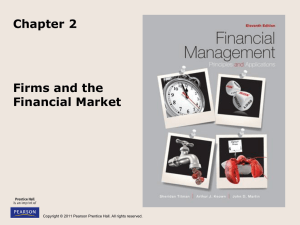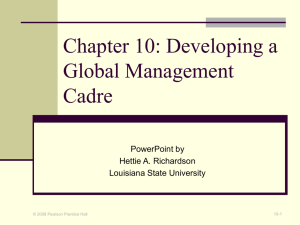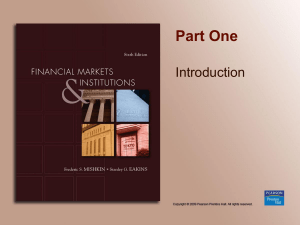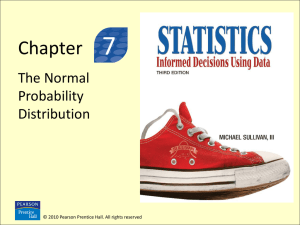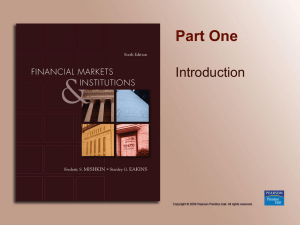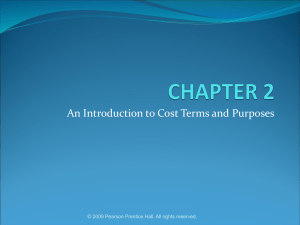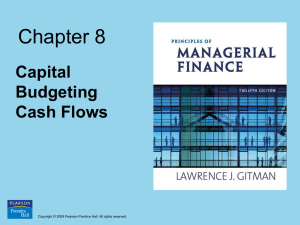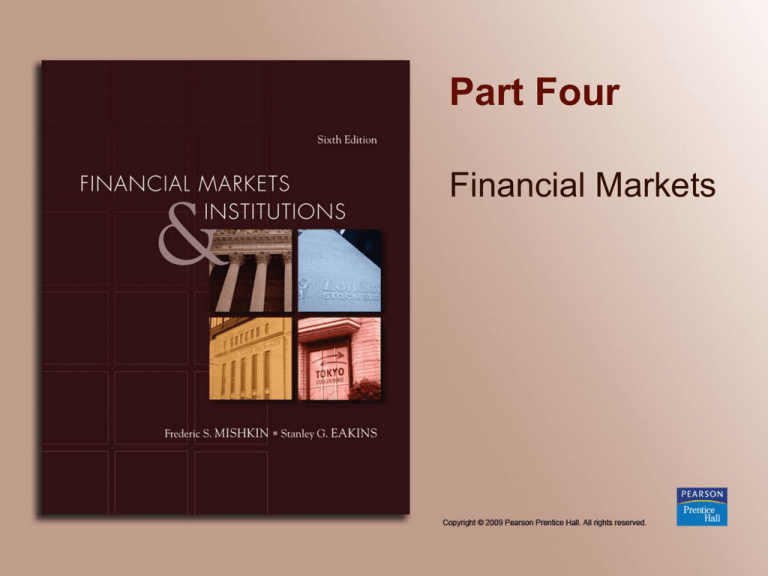
Part Four
Financial Markets
Chapter 9
The Money
Markets
Now that’s a lot!
In its 2006 annual report, Microsoft listed
$27 billion in short-term securities on its
balance sheet. This is essentially cash, but
Microsoft does not keep this in its local
bank. But where?
This is, of course, this topic of chapter 9 –
Money Markets.
Copyright © 2009 Pearson Prentice Hall. All rights reserved.
9-3
Chapter Preview
• We review the money markets and the securities
that are traded there. In addition, we discuss why
the money markets are important in our financial
system. Topics include:
– The Money Markets Defined
– The Purpose of Money Markets
– Who Participates in Money Markets?
– Money Market Instruments
– Comparing Money Market Securities
Copyright © 2009 Pearson Prentice Hall. All rights reserved.
9-4
The Money Markets Defined
The term “money market” is a misnomer.
Money (currency) is not actually traded in
the money markets. The securities in the
money market are short term with high
liquidity; therefore, they are close to
being money.
Copyright © 2009 Pearson Prentice Hall. All rights reserved.
9-5
The Money Markets Defined
• Money Markets Defined
1. Money market securities are usually sold in
large denominations ($1,000,000 or more)
2. They have low default risk
3. They mature in one year or less from their
issue date
Copyright © 2009 Pearson Prentice Hall. All rights reserved.
9-6
The Money Markets Defined:
Why Do We Need Money Markets?
In theory, the banking industry should
handle the needs for short-term loans and
accept short-term deposits. Banks also
have an information advantage on the
credit-worthiness of participants.
Banks do mediate between savers and
borrowers; however, they are heavily
regulated. This creates a distinct cost
advantage for money markets over banks.
Copyright © 2009 Pearson Prentice Hall. All rights reserved.
9-7
The Money Markets Defined:
Cost Advantages
• Reserve requirements create additional expense
for banks that money markets do not have
• Regulations on the level of interest banks could
offer depositors lead to a significant growth in
money markets, especially in the 1970s and
1980s. When interest rates rose, depositors
moved their money from banks to money markets
to earn a higher interest rate.
Copyright © 2009 Pearson Prentice Hall. All rights reserved.
9-8
The Money Markets Defined:
Cost Advantages
• Even today, the cost structure of banks
limits their competitiveness to situations
where their informational advantages
outweighs their regulatory costs.
• Figure 1 shows that limits on interest banks
could offer was not relevant until the 1950s.
But in the decades that followed, the
problem became apparent.
Copyright © 2009 Pearson Prentice Hall. All rights reserved.
9-9
3-month T-bill rates and
Interest Rate Ceilings
Copyright © 2009 Pearson Prentice Hall. All rights reserved.
9-10
The Purpose of Money Markets
• Investors in Money Market: Provides a
place for warehousing surplus funds for
short periods of time
• Borrowers from money market provide lowcost source of temporary funds
Copyright © 2009 Pearson Prentice Hall. All rights reserved.
9-11
The Purpose of Money Markets
• Corporations and U.S. government use
these markets because the timing of cash
inflows and outflows are not well
synchronized. Money markets provide a
way to solve these cash-timing problems.
Copyright © 2009 Pearson Prentice Hall. All rights reserved.
9-12
Who Participates
in the Money Markets?
• We will discuss, in turn, each of the
major borrowers and lenders in the
money market.
• Before we do that, let’s examine some of
the current rates offered in the U.S. money
markets. Some of these rates have been
discussed in previous chapters. Other
rates will be explored throughout
this chapter.
Copyright © 2009 Pearson Prentice Hall. All rights reserved.
9-13
Who Participates in the Money Markets?: A
Sample from the Wall Street Journal
Copyright © 2009 Pearson Prentice Hall. All rights reserved.
9-14
Who Participates
in the Money Markets?
Money Market Instruments
• We will examine each of these in the
following slides:
– Treasury Bills
– Federal Funds
– Repurchase Agreements
– Negotiable Certificates of Deposit
Copyright © 2009 Pearson Prentice Hall. All rights reserved.
9-16
Money Market Instruments (cont.)
• We will examine each of these in the
following slides (continued):
– Commercial Paper
– Banker’s Acceptance
– Eurodollars
Copyright © 2009 Pearson Prentice Hall. All rights reserved.
9-17
Money Market Instruments:
Treasury Bills
• T-bills have 28-day maturities through 12month maturities.
• Discounting: When an investor pays less
for the security than it will be worth when it
matures, and the increase in price
provides a return. This is common to
short-term securities because they often
mature before the issuer can mail out
interest checks.
Copyright © 2009 Pearson Prentice Hall. All rights reserved.
9-18
Money Market Instruments:
Treasury Bills Discounting Example
• You pay $996.37 for a 28-day T-bill. It is worth
$1,000 at maturity. What is its discount rate?
i discount
i discount
F P
x
F
1, 000 996 . 73
1, 000
Copyright © 2009 Pearson Prentice Hall. All rights reserved.
360
(1)
n
x
360
4 . 665 %
28
9-19
Money Market Instruments:
Treasury Bills Discounting Example
• You pay $996.37 for a 28-day T-bill. It is worth
$1,000 at maturity. What is its annualized yield?
iyt
i yt
F P
1, 000 996 . 73
P
x
366
996 . 37
Copyright © 2009 Pearson Prentice Hall. All rights reserved.
365
n
(1)
4 . 76 %
28
9-20
Money Market Instruments:
Treasury Bill Auctions
• T-bills are auctioned to the dealers
every Thursday.
• The Treasury may accept both competitive
and noncompetitive bids, and the price
everyone pays is the highest yield paid to
any accepted bid.
Copyright © 2009 Pearson Prentice Hall. All rights reserved.
9-21
Money Market Instruments:
Treasury Bill Auctions Example
The Treasury auctioned $2.5 billion par value 91-day Tbills, the following bids were received:
Bidder
1
2
3
4
5
Bid Amount
$500 million
$750 million
$1.5 billion
$1 billion
$600 million
Bid Price
$0.9940
$0.9901
$0.9925
$0.9936
$0.9939
The Treasury also received $750 million in noncompetitive
bids. Who will receive T-bills, what quantity, and at what
price?
Copyright © 2009 Pearson Prentice Hall. All rights reserved.
9-22
Money Market Instruments:
Treasury Bill Auctions Example
The Treasury accepts the following bids:
Bidder
1
5
4
Bid Amount
$500 million
$600 million
$650 million
Bid Price
$0.9940
$0.9939
$0.9936
Both the competitive and noncompetitive bidders pay the
highest yield – based on the price of 0.9936:
Copyright © 2009 Pearson Prentice Hall. All rights reserved.
9-23
Money Market Instruments:
Treasury Bill Rates
The next slide shows the results of several
Treasury bill auctions, from 2007.
It also shows some other data about each
auction. Do you know what each term
means?
Copyright © 2009 Pearson Prentice Hall. All rights reserved.
9-24
Money Market Instruments:
Treasury Bill Auction Results
Copyright © 2009 Pearson Prentice Hall. All rights reserved.
9-25
Money Market Instruments:
Treasury Bill Rates
The next slide shows actual T-bill rates
and the annual rate of inflation from 1973
through 2007.
Notice that the inflation rate exceeds the
rate on T-bills in several on the years.
This indicates a negative real return for
T-bill investors during these periods.
Copyright © 2009 Pearson Prentice Hall. All rights reserved.
9-26
Money Market Instruments:
Treasury Bills
Copyright © 2009 Pearson Prentice Hall. All rights reserved.
9-27
Money Market Instruments:
Fed Funds
• Short-term funds transferred (loaned or
borrowed) between financial institutions,
usually for a period of one day.
• Used by banks to meet short-term needs to
meet reserve requirements.
Copyright © 2009 Pearson Prentice Hall. All rights reserved.
9-28
Money Market Instruments:
Fed Funds Rates
The next slide shows actual fed funds
rates and T-bill rates 1990 through 2006.
Notice that the two rates track fairly
closely. What does this suggest about
the market for T-bills and the market for
fed funds?
Copyright © 2009 Pearson Prentice Hall. All rights reserved.
9-29
Money Market Instruments:
Fed Funds Rates
Copyright © 2009 Pearson Prentice Hall. All rights reserved.
9-30
Money Market Instruments: Repurchase
Agreements
• These work similar to the market for fed
funds, but nonbanks can participate.
• A firm sells Treasury securities, but agrees
to buy them back at a certain date (usually
3–14 days later) for a certain price.
Copyright © 2009 Pearson Prentice Hall. All rights reserved.
9-31
Money Market Instruments: Repurchase
Agreements
• This set-up makes a repo agreements
essentially a short-term collateralized loan.
• This is one market the Fed may use to
conduct its monetary policy, whereby the
Fed purchases/sells Treasury securities in
the repo market.
Copyright © 2009 Pearson Prentice Hall. All rights reserved.
9-32
Money Market Instruments: Negotiable
Certificates of Deposit
• A bank-issued security that documents a
deposit and specifies the interest rate and
the maturity date
• Denominations range from $100,000
to $10 million
Copyright © 2009 Pearson Prentice Hall. All rights reserved.
9-33
Money Market Instruments: Negotiable
Certificates of Deposit
The next slide shows actual CD rates and
T-bill rates 1990 through 2007.
Again, notice that the two rates track fairly
closely. What does this suggest about the
market for T-bills and the market for CDs?
Copyright © 2009 Pearson Prentice Hall. All rights reserved.
9-34
Money Market Instruments: Negotiable
CD Rates
Copyright © 2009 Pearson Prentice Hall. All rights reserved.
9-35
Money Market Instruments: Commercial
Paper
• Unsecured promissory notes, issued by
corporations, that mature in no more than
270 days.
• The use of commercial paper increased
significantly in the early 1980s because of
the rising cost of bank loans.
Copyright © 2009 Pearson Prentice Hall. All rights reserved.
9-36
Money Market Instruments: Commercial
Paper
The next slide shows actual commercial
paper rates and the prime rates 1990
through 2007.
Although the two track closely in terms of
movements, notice that difference
between the two remains roughly 200
basis points.
Copyright © 2009 Pearson Prentice Hall. All rights reserved.
9-37
Money Market Instruments: Commercial
Paper Rates
Copyright © 2009 Pearson Prentice Hall. All rights reserved.
9-38
Money Market Instruments: Commercial
Paper
The next slide shows actual commercial
paper volume by year from 1990
through 2006.
Notice that the volume has only begun to
fall during the recent economic recession
in the economy. Even so, the annual
market is still quite large, at well over $1
trillion outstanding.
Copyright © 2009 Pearson Prentice Hall. All rights reserved.
9-39
Money Market Instruments: Commercial
Paper Volume
Copyright © 2009 Pearson Prentice Hall. All rights reserved.
9-40
Money Market Instruments:
Banker’s Acceptances
• An order to pay a specified amount
to the bearer on a given date if specified
conditions have been met, usually delivery
of promised goods.
• These are often used when buyers / sellers
of expensive goods live in different
countries.
Copyright © 2009 Pearson Prentice Hall. All rights reserved.
9-41
Money Market Instruments:
Banker’s Acceptances Advantages
1. Exporter paid immediately
2. Exporter shielded from foreign
exchange risk
3. Exporter does not have to assess the
financial security of the importer
4. Importer’s bank guarantees payment
5. Crucial to international trade
Copyright © 2009 Pearson Prentice Hall. All rights reserved.
9-42
Money Market Instruments:
Banker’s Acceptances
• As seen, banker’s acceptances avoid the
need to establish the credit-worthiness of a
customer living abroad.
• There is also an active secondary market
for banker’s acceptances until they mature.
The terms of note indicate that the bearer,
whoever that is, will be paid upon maturity.
Copyright © 2009 Pearson Prentice Hall. All rights reserved.
9-43
Money Market Instruments: Eurodollars
• Eurodollars represent Dollar denominated
deposits held in foreign banks.
• The market is essential since many foreign
contracts call for payment is U.S. dollars
due to the stability of the dollar, relative to
other currencies.
Copyright © 2009 Pearson Prentice Hall. All rights reserved.
9-44
Money Market Instruments: Eurodollars
• The Eurodollar market has continued to grow
rapidly because depositors receive a higher rate
of return on a dollar deposit in the Eurodollar
market than in the domestic market.
• Multinational banks are not subject to the same
regulations restricting U.S. banks and because
they are willing to accept narrower spreads
between the interest paid on deposits and the
interest earned on loans.
Copyright © 2009 Pearson Prentice Hall. All rights reserved.
9-45
Money Market Instruments: Eurodollars
Rates
• London interbank bid rate (LIBID)
– The rate paid by banks buying funds
• London interbank offer rate (LIBOR)
– The rate offered for sale of the funds
• Time deposits with fixed maturities
– Largest short term security in the world
Copyright © 2009 Pearson Prentice Hall. All rights reserved.
9-46
Global: Birth of the Eurodollar
• The Eurodollar market is one of the most
important financial markets, but oddly
enough, it was fathered by the Soviet Union.
• In the 1950s, the USSR had accumulated
large dollar deposits, but all were in US
banks. They feared the US might seize
them, but still wanted dollars. So, the USSR
transferred the dollars to European banks,
creating the Eurodollar market.
Copyright © 2009 Pearson Prentice Hall. All rights reserved.
9-47
Comparing Money Market Securities
• The next slide shows a comparison of
various money market rates from 1990
through 2007.
• Notice that no real pattern is present
among the rates, indicating that investor
preferences to the features on the
instruments fluctuates.
Copyright © 2009 Pearson Prentice Hall. All rights reserved.
9-48
Comparing Money Market Securities : A
comparison of rates
Copyright © 2009 Pearson Prentice Hall. All rights reserved.
9-49
Comparing Money Market Securities
• The next slide summarizes the types of
securities, issuers, buyers, maturity, and
secondary market characteristics.
Copyright © 2009 Pearson Prentice Hall. All rights reserved.
9-50
Comparing Money Market Securities: Money
Market Securities and Their Depth
Copyright © 2009 Pearson Prentice Hall. All rights reserved.
9-51
Chapter Summary
• The Money Markets Defined
– Short-term instruments
– Most have a low default probability
• The Purpose of Money Markets
– Used to “warehouse” funds
– Returns are low because of low risk and
high liquidity
Copyright © 2009 Pearson Prentice Hall. All rights reserved.
9-52
Chapter Summary (cont.)
• Who Participates in Money Markets?
– U.S. Treasury
– Commercial banks
– Businesses
– Individuals (through mutual funds)
• Money Market Instruments
– Include T-bills, fed funds, etc.
Copyright © 2009 Pearson Prentice Hall. All rights reserved.
9-53
Chapter Summary (cont.)
• Comparing Money Market Securities
– Issuers range from the US government to
banks to large corporations
– Mature in as little as 1 day to as long as 1 year
– The secondary market liquidity
varies substantially
Copyright © 2009 Pearson Prentice Hall. All rights reserved.
9-54

